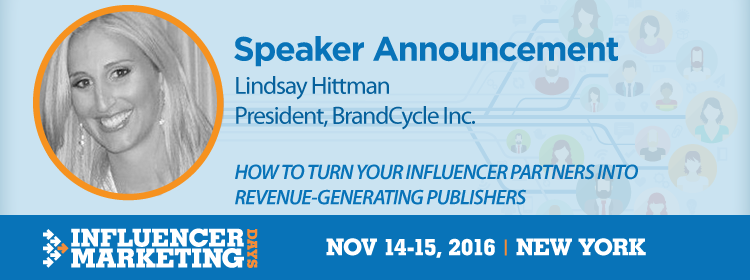My today’s guest is Lindsay Hittman, the Co-Founder and President of BrandCycle. On Day 2 of our New York City conference she will present on “How to Turn your Influencer Partners into Revenue-Generating Publishers.” In this pre-conference interview I’ve asked her some of the burning questions that marketing managers and brands, in general, have while approaching influencer marketing.
Question: While the concept is centuries old, influencer marketing became the “buzz word” only a couple of years ago, and advertisers’ interest in it is only getting stronger. What do you think about influencer marketing?
 Lindsay: Influencer marketing is extremely important and can’t be overlooked by brands wishing to connect with their target audiences. In terms of affordability, it’s an incredibly cost-effective way to reach a large pool of people who have established a voice in their communities and social spheres.
Lindsay: Influencer marketing is extremely important and can’t be overlooked by brands wishing to connect with their target audiences. In terms of affordability, it’s an incredibly cost-effective way to reach a large pool of people who have established a voice in their communities and social spheres.
Question: What’s the biggest misconception you’ve seen brands have about influencer marketing?
Lindsay: A lot of brands don’t fully realize the scale at which they could reach customers through influencers. Marketing teams tend to focus on the biggest influencers and can easily get lost in statistics and numbers. In reality, this is a space that offers the freedom and flexibility to interact with a much larger group of influencers. It’s very cost effective to cast a wider net, so why not do it?
Question: What top 3 mistakes should advertisers be aware of as they look into getting their feet wet in/with influencer marketing?
Lindsay:
1. Underestimating Smaller Influencers
Avoid placing too much emphasis on an influencer’s statistics, rankings or social shares. Be willing to work with influencers of all sizes to build long-term relationships. You never know who might write the next viral post, so getting in early with influencers can mean a lot for your brand.
2. Setting up Rigid Brand Guidelines
Trust influencers to share your brand’s vision in a unique, true-to-themselves way. If you provide editorial content that can’t be altered, you lose authenticity and will likely lose influencers. Provide parameters to work within, but allow your influencers to put their own spin on the content you provide.
3. Sticking to One Compensation Model
Be open to a combination of compensation methods. You don’t have to solely compensate on soft metrics or only pay out based on hard metrics. The influence marketing industry changes daily, and your compensation strategy should be fluid enough to react to those changes.
Question: What is the biggest overlooked influencer marketing opportunity, in your opinion?
Lindsay: Many brands compensate influencers solely on soft metrics, but there’s a big opportunity to integrate performance marketing into your model and compensate influencers using a cost per acquisition (CPA) model. With this opportunity, brands only pay out when a sale is made. This allows companies to work with a seemingly unlimited group of influencers who can reach a larger audience, at no up front cost.
Question: With 2017 just around the corner, what would you recommend for advertisers to consider implementing as soon as Q4 is over (a New Year’s influencer marketing resolution of sorts)?
Lindsay: Test CPA compensation with an initial pool of mid- and long-tail influencers.
Question: What do you believe to be the biggest challenge that advertisers face in terms of influencer marketing, and what steps can they take to overcome it?
Lindsay: Budget allocation can be a huge hurdle for brands. We’ve seen brands that allocate separate budgets and goals for performance marketing and influencer marketing. Unfortunately, this constrains how you interact with your influencers. By creating one overarching budget that encompasses all of these initiatives, you can be flexible enough to move with your audience.
Question: Give us one main reason why marketers should attend your Influencer Marketing Days session.
Lindsay: Influencer marketing is a hot topic right now, but most brands don’t understand the exact steps to take to tap into the space in an affordable, easy way. We’ll walk through the tactical strategy that brands can implement, and really get into the nuts and bolts of how to implement an influencer marketing program.
Question: If you were to leave brands with one piece of influencer marketing advice, what would it be?
Lindsay: Start now! You only need a small pool of people to test influencer marketing with and see what works. Then, be nimble enough to follow those insights and move forward.


Recent Comments